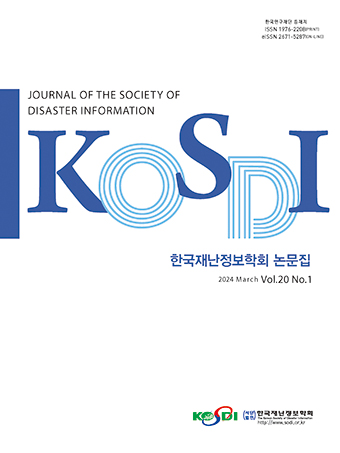Research Article
Abstract
References
Information
Purpose: The purpose of this study is to accurately analyze the damage of bridges in order to determine whether fire bridges can be used continuously or to provide information on maintenance augmentation data. Method: XRD, SEM and EDS analyzes of concrete were carried out to estimate the fire temperature transferred to the structure, and analyzed by depth and area from PSCI beam and bottom plate concrete surface. Results: Test results G12,11 for the fire zone concrete were confirmed to be affected by heat up to depth of 60mm and the temperature of the hydrothermal heat was above 1000 °C. Also, the girder G10,9,8 was relatively weakly damaged compared to G12,11, and the degree of damage was confirmed to be affected by heat up to a depth of 40 mm. Conclusion: Based on the analyzed data, it is considered that if the repair / reinforcement and periodic inspection are carried out, the bridge can secure sufficient safety even considering the damage caused by the fire.
연구목적: 본 연구의 목적은 화재가 발생한 교량의 지속적인 사용가능 여부를 결정하고 보수·보강에 대한 근거자료를 제공하기 위해 교량의 화재 손상여부를 정확하게 분석하는 것이다. 연구방법: 구조물에 전달된 화재온도를 추정하기 위하여 콘크리트의 XRD, SEM 및 EDS 분석 등을 실시하였으며, PSCI Beam 및 바닥판 콘크리트 표면으로부터의 깊이별, 구역별로 분석하였다. 연구결과: 화재구간 콘크리트에 대한 시험결과 G12,11은 깊이 60mm까지 열에 의한 영향이 미친 것으로 확인되었고 수열온도는 최대 1000°C 이상인 것으로 나타났다. 그리고 G10,9,8 거더는 G12,11에 비해 상대적으로 약한 피해를 입었으며 피해 정도는 최대 40mm 깊이까지 열에 의한 영향을 받은 것으로 확인되었다. 결론: 분석된 자료를 근거로 보수‧보강과 정기적인 점검을 시행한다면 본 교량은 화재에 의한 손상을 감안하더라도 충분한 안전성을 확보할 수 있을 것으로 사료된다.
- Garlockand Ignacio Paya-Zaforteza, M., Kodur, V., Gu, L. (2011). "Fire hazard in bridges: Review, assesment and repair strategies," Engineering Structures.10.1016/j.engstruct.2011.11.002
- Hager, I. (2013). "Behaviour of cement concrete at high temperature Bulletin of the Polish Academy of Sciences." Technical Sciences, Vol.61, No.1, pp.145-154.10.2478/bpasts-2013-0013
- Hertz, K.D. (2003). "Limits of spalling of fire-exposed concrete." Fire Safety Journal, Vol.38, No.2, pp.103-116.10.1016/S0379-7112(02)00051-6
- ITA (International Tunneling Association) (2004). Guidelines for structural fire resistance for road tunnels. Working Group No.6 Maintenance and Repair.
- Li, M., Qian, C.X., Sun, W. (2004). "Mechanical properties of high-strength concrete after fire." Cement and Concrete Research, Vol.34, No.6, pp.1001-1005.10.1016/j.cemconres.2003.11.007
- Ma, Q., Guo, R., Zhao, Z., Lin, Z., He, K. (2015). "Mechanical properties of concrete at high temperature: A review." Construction and Building Materials, Vol.93, pp.371-383.10.1016/j.conbuildmat.2015.05.131
- M.E.K. David N. Bilow (2008). "Fire and concrete structures," Structures 2008: Crossing Borders.
- Pay'a-Zaforteza, I., Garlock, M. (2012). "A numerical investigation on the fire response of a steel girder bridge," Journal of Constructional Steel Research.10.1016/j.jcsr.2012.03.012
- Phan, L.T. (1996). Fire performance of high strength concrete: A report of the state of the art. NISTIR 5934, National Institute of Standards and Technology, Gaithersburg, Maryland.10.6028/NIST.IR.5934
- Sangluaia, M.C., Haridharan, M.M.K., Natarajan, D.C., Rajaraman, D.A. (2013). "Behaviour of reinforced concrete slab subjected to fire," International Journal of Computational Engineering Research, Vol.3, No.1, pp.203-215.
- Publisher :The Korean Society of Disaster Information
- Publisher(Ko) :한국재난정보학회
- Journal Title :Journal of the Society of Disaster Information
- Journal Title(Ko) :한국재난정보학회논문집
- Volume : 15
- No :4
- Pages :479-492
- DOI :https://doi.org/10.15683/kosdi.2019.12.31.479




 Journal of the Society of Disaster Information
Journal of the Society of Disaster Information







